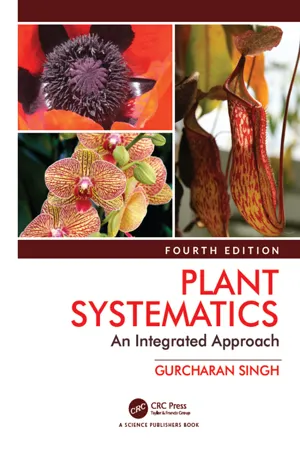Biological Sciences
Pteridophytes
Pteridophytes are a group of vascular plants that reproduce via spores. They are characterized by their lack of seeds and flowers, and instead produce spores on the underside of their fronds. Pteridophytes include ferns, horsetails, and clubmosses, and are known for their ability to thrive in moist environments.
Written by Perlego with AI-assistance
Related key terms
3 Key excerpts on "Pteridophytes"
- eBook - ePub
Plant Systematics
An Integrated Approach, Fourth Edition
- Gurcharan Singh(Author)
- 2019(Publication Date)
- CRC Press(Publisher)
11Families of Pteridophytes
Pteridophytes, Gymnosperms and Angiosperms constitute Tracheophytes, a dominant group of green plants, characterized by the presence of a well-developed branched, independent and dominant sporophyte, with a vascular system consisting of xylem (tracheids-hence the name Tracheophytes, vessels in angiosperms) and phloem (sieve elements, sieve tubes in angiosperms). The group evolved nearly 420 million years ago and is regarded as monophyletic. Pteridophytes, the seedless vascular plants differ from higher Tracheophytes in lacking seed habit and absence of pollen tube, spores developing freely into gametophytes, although few members exhibit heterospory and the reduction of megaspore number to one, forerunner of seed habit.CLASSIFICATION
Pteridophytes form a complex heterogenous group reflecting antiquity and divergent evolutionary clades and have been classified variously. Engler and Prantl recognized Bryophyta and Pteridophyta as two subdivisions of the division Embryophyta Asiphonogama. Cronquist et al. (1966) recognized four groups within Pteridophytes, each given the rank of a division: Psilophyta, Lycopodiophyta, Equisetophyta and PolypodiophytaBold, Alexopoulos and Delevoryas (1987) included the same four group but preferred name Microphyllophyta for Lycopodiophyta and Arthrophyta for Equisetophyta. Recent evidence indicates that Pteridophytes often separated under ‘Ferns and Fern Allies’, form a paraphyletic assemblage of groups, which represent distinct evolutionary lines and are lumped together for convenience. Recent genetic data has shown that Lycopodiophyta are only distantly related to other vascular plants, having radiated evolutionarily at the base of vascular plant clade, whereas Psilophyta and Equisetophyta are much closer to true ferns.Classification of Smith et al.
A more recent classification of Smith et al. (2006), based on morphology as well as molecular data as such excludes Lycopodiophytes from Ferns. The classification recognizes 4 classes, 11 orders and 37 families under ferns. They estimated Peridophytes include nearly 10280 species, 1280 belonging to lycophytes and nearly 9000 to ferns: - eBook - ePub
Biology
A Self-Teaching Guide
- Steven D. Garber(Author)
- 2020(Publication Date)
- Jossey-Bass(Publisher)
sporangia produce spores that are covered with a protective jacket of sterile cells.BRYOPHYTA: MOSSES, LIVERWORTS, AND HORNWORTS
The bryophytes represent about 25,000 species of mosses, liverworts, and hornworts. On the basis of any one characteristic it is difficult to distinguish them from the thallophytes, or from what are sometimes referred to as the true algae. In contrast to algae, which tend to be composed of either single cells or filaments (sheets of cells), which can intertwine to create more complex body structures, bryophytes are rarely filamentous, except during one stage in the life history of the mosses. Instead, bryophytes are composed of cells that form tissues called parenchyma; they are characterized by loosely fitting cells that have thin walls of cellulose. In between the cells are intercellular spaces incorporated within the cellular network.In bryophytes, the principal photosynthetic pigments are chlorophyll a and b. These are biochemically similar to the pigments of the chlorophytes, from which bryophytes probably arose. Their energy reserves are stored in the form of starch, and their cell walls contain cellulose.Bryophytes are usually terrestrial. But they remain somewhat dependent on their ancestral aquatic environment. This has kept their distribution limited to moist environments or to environments that are moist during a critical period each year. These small plants need water for their flagellated sperm cells to swim from the antheridia to the egg cells in the archegonia. Without any vascular tissue, their ability to move fluids internally across long distances is limited. And since xylem, the vascular tissue in higher plants, is necessary for support, the upper size limit of these plants without such supportive tissue is kept at a minimum.All the bryophytes have an alternation of generations, with a sporophyte generation (diploid) and a gametophyte generation (haploid). Among the larger, more complex algae, most of which have an alternation of generations, there is some tendency toward a reduction of the gametophyte, multicellular stage, and an emphasis on the sporophyte, multicellular stage. In both the brown and red algae, the sporophyte generation is prominent, as is the case in the vascular plants. This tendency is not apparent in the bryophytes, in which the haploid gametophyte stage is clearly dominant. It is the leafy green gametophytic stage of the bryophytes that produces the gametes. These swim through moisture, present as a film of either rain or dew, from the antheridia to the archegonia. Here the sperm fertilize the eggs, producing zygotes that make diploid sporophytes by mitotic division. The sporophyte plant is attached to the gametophyte and grows directly from it. The sporophyte produces the sporangia, organs that contain and release the asexual spores. Spores are asexual because, unlike gametes, they never meet in a sexual union. (See page 73 , Figure 4.5 - eBook - ePub
- Patricia Barnes-Svarney, Thomas E. Svarney(Authors)
- 2014(Publication Date)
- Visible Ink Press(Publisher)
Bryophytes —These are the nonvascular plants. Because bryophytes lack a system for conducting water and nutrients, they are restricted in size and live in moist areas close to the ground. Examples of bryophytes are mosses, liverworts, and hornworts and are most often found in moist environments—mainly because they require water to reproduce sexually. (However, species inhabit almost every environment, from hot, dry deserts to the coldest regions of the Antarctica continent.) Overall, they are the second largest group of land plants after flowering plants. They are generally small, compact plants that rarely grow to more than 8 inches (20 centimeters) tall. They have parts that appear leaflike, stemlike, and rootlike and lack vascular tissue (xylem and phloem). Most species have certain structures that help them to retain moisture around their sperm-producing and egg-producing structures and large gametophytes that hold on to sporophytes.Tracheophytes —These are the vascular plants, which are further divided into seedless plants and those that contain seeds. Plants with seeds are divided into flowering and nonflowering groups. Examples of seedless, vascular plants are ferns, horsetails, and club mosses. The cone-bearing conifers are seed-bearing, nonflowering vascular plants. It’s interesting to note that the majority of plants on Earth are seed-bearing, flowering, vascular plants—known as angiosperms.BRYOPHYTES
Why are bryophytes important to the study of early plants?
Some scientists believe bryophytes called liverworts are some of the closest living relatives of early land plants; they are thought to have evolved from freshwater, multicellular, green algae. Fossils of liverwort plants were found in 2010 in the Central Andean Basin of northwest Argentina. The scientists who made the discovery believe that this bryophyte plant—which lacked stems or roots—may be evidence that plants evolved on land ten million years earlier than previously thought. They found spores from the liverwort fossil that dated from between 473 and 471 million years ago, making these very simple plants the oldest land plant remains found to date.
Learn about this page
Index pages curate the most relevant extracts from our library of academic textbooks. They’ve been created using an in-house natural language model (NLM), each adding context and meaning to key research topics.


